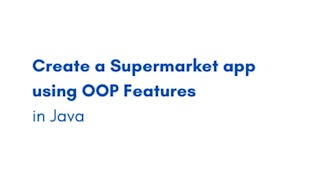This course is an introduction to the Java programming language and the concepts of object-oriented design. It not only covers the fundamentals of programming in Java, but it also brings in the concepts of object-oriented design and guides students to build GUI-based applications to address real-world problems. Topics include, but not limited to, fundamentals of programming in Java, classes and methods, objects and references, overloading, inheritance, polymorphism, abstract classes and interfaces, basic data structures, and GUI applications. Students are expected to apply learned knowledge to address an identified problem found in the real world.

Enjoy unlimited growth with a year of Coursera Plus for $199 (regularly $399). Save now.

Recommended experience
Skills you'll gain
Details to know

Add to your LinkedIn profile
10 assignments
See how employees at top companies are mastering in-demand skills

There are 4 modules in this course
In this module, you will be setting up the foundation to learn computation and programming, review the fundamentals of programming using Java programming language and write Java programs with basic syntax, including variables, I/O, Strings, control flow, conditions, methods, arrays, and file I/O.
What's included
6 videos52 readings1 assignment2 discussion prompts
You will continue exploring object-oriented programming by focusing on the concept of arrays of objects by creating and manipulating multiple instances of objects in a sequential manner, learning how to pass objects to methods, along with an in-depth examination of class abstraction and encapsulation. You will extend your exploration to wrapper classes and harness the capabilities of String, StringBuilder, and StringBuffer classes to devise solutions for real-world problems.
What's included
5 videos40 readings2 assignments1 discussion prompt
This module, you will be taking a closer look into the world of Graphical User Interface (GUI) programming which are the essential components of modern software applications, enabling users to interact with software in a visually intuitive and user-friendly manner. You will learn the fundamental principles of designing and creating basic GUI applications.During this week, you will also recall the fundamental characteristics of each GUI toolkit and articulate, and demonstrate the ability to configure a programming environment for JavaFX and apply basic programming skills to write and execute simple JavaFX applications and create user interfaces using pages, groups, UI controls and shapes.
What's included
4 videos39 readings2 assignments1 discussion prompt
This module, you will be introduced to event-driven programming, a paradigm to respond to various events or actions. Primarily focusing on how applications can be designed to respond to user actions on JavaFX GUI applications. This week's topic emphasizes explaining the mechanism and designing responses for interaction in JavaFX. You will also learn about the concept of handler classes in event-driven programming, including how handler objects are registered to respond to specific events. You will learn how to describe events, event sources, and event classes and apply that to write and analyze code that effectively manages and responds to various events.
What's included
9 videos49 readings5 assignments1 discussion prompt
Prepare for a degree
Taking this course by Northeastern University may provide you with a preview of the topics, materials and instructors in a related degree program which can help you decide if the topic or university is right for you.
Instructor

Offered by
Explore more from Software Development
 Status: Free Trial
Status: Free Trial Status: Preview
Status: PreviewNortheastern University
 Status: Preview
Status: PreviewNortheastern University
Why people choose Coursera for their career





Open new doors with Coursera Plus
Unlimited access to 10,000+ world-class courses, hands-on projects, and job-ready certificate programs - all included in your subscription
Advance your career with an online degree
Earn a degree from world-class universities - 100% online
Join over 3,400 global companies that choose Coursera for Business
Upskill your employees to excel in the digital economy
Frequently asked questions
To access the course materials, assignments and to earn a Certificate, you will need to purchase the Certificate experience when you enroll in a course. You can try a Free Trial instead, or apply for Financial Aid. The course may offer 'Full Course, No Certificate' instead. This option lets you see all course materials, submit required assessments, and get a final grade. This also means that you will not be able to purchase a Certificate experience.
When you purchase a Certificate you get access to all course materials, including graded assignments. Upon completing the course, your electronic Certificate will be added to your Accomplishments page - from there, you can print your Certificate or add it to your LinkedIn profile.
Yes. In select learning programs, you can apply for financial aid or a scholarship if you can’t afford the enrollment fee. If fin aid or scholarship is available for your learning program selection, you’ll find a link to apply on the description page.
More questions
Financial aid available,


